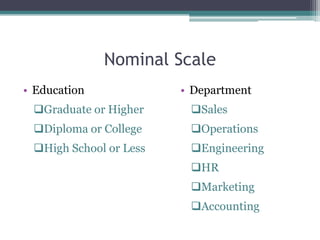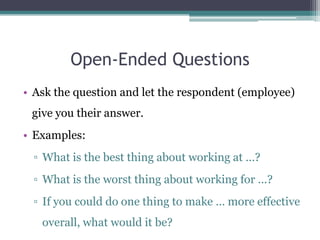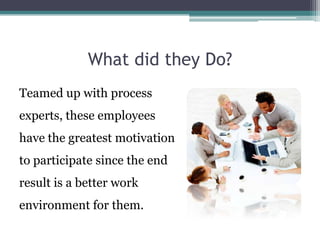Employee Satisfaction
- 1. Case StudyAnalyzing Employee SatisfactionCase Study
- 2. A good company aims to keep its employees happy because happy people are more productive people.But…How Do You Know if People are Happy in their Jobs?How do you know whether the employees are spending their time on value-added activities?
- 3. Case StudyA recent data analysis inside a company indicated that the employees in a certain job category were leaving the company at twice the rate as the company average.
- 4. Possible ReasonsThe BossThe Pay….How to Find Out what is really happening?
- 6. What is a Survey?Survey refers to a quantitative research; a method used to collect in a systematic way, information from a sample of individuals.Quantitative Research
- 7. What is a Survey?A survey may focus on different topics such as preferences (e.g., for doing a specific task), behavior (e.g., time management), or factual information (e.g., job category), depending on its purpose.
- 8. Survey StructureA survey consists of a number of questions that the respondent has to answer in a set format.It may contain open-ended questions, closed-ended questions, or both.
- 9. Closed-Ended QuestionsClosed-Ended Questions are a form of questions that can be answered using preset choices.Response Scales:DichotomousNominalOrdinal – Likert Scale
- 11. Nominal ScaleEducationGraduate or Higher
- 13. High School or LessDepartmentSales
- 14. Operations
- 15. Engineering
- 16. HR
- 17. Marketing
- 18. AccountingOrdinal (Likert) ScaleA psychometric scale commonly used in questionnaires, and is the most widely scale used in survey research.
- 19. Examples of Likert ScaleCurrently, how satisfied are you with your job overall? (Job Satisfaction)Currently, how committed are you to your organization? (Organizational Commitment)1235412354VeryDissatisfiedDissatisfiedI am not sureVerySatisfiedSatisfiedNot at AllTo a Very Little ExtentTo Some ExtentTo a Very Great ExtentTo a Great Extent
- 20. Examples of Likert Scale
- 21. Open-Ended QuestionsAsk the question and let the respondent (employee) give you their answer.Examples:What is the best thing about working at …?What is the worst thing about working for …?If you could do one thing to make … more effective overall, what would it be?
- 22. Continuous ScaleContinuous scale measures continuous variables and is used to answer an open-ended question.A continuous variable is one for which a subject or observation takes a value from an interval of real numbers (e.g., age, height, income).
- 23. Back to our Case StudyA survey was developed to request the opinions of nearly 2,000 employees that hold this job title.
- 24. Survey ContentsA long list of the tasks that were involved in performing the job,a data field to enter the number of hours spent on each activity per week, anda field from 1 to 5 ranking the importance of each activity for the business.
- 25. Survey Process
- 26. Survey Results
- 27. Survey ConclusionEmployees are spending a great deal of time on some activities although these activities are of little value to the company.
- 28. DecisionsThese activities should be put on a list for possible elimination, automation or process improvement to reduce the time spent on them.A prioritized list can now be provided to a team of improvement experts (employees).
- 29. What did they Do?Teamed up with process experts, these employees have the greatest motivation to participate since the end result is a better work environment for them.
- 31. Thank You!
























